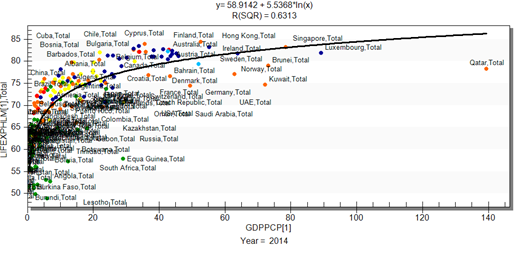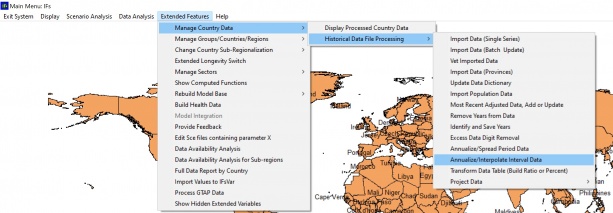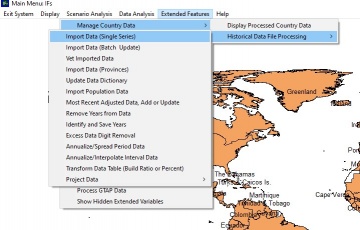United Nations Population Division (UNPD)
About the UNPD
The Population Division was established in the earlier years of the United Nations to serve as the Secretariat of the then Population Commission, created in 1946. Over the years, the Division has played an active role in the intergovernmental dialogue on population and development, producing constantly updated demographic estimates and projections for all countries, including data essential for the monitoring of the progress in achieving the Millennium Development Goals, developing and disseminating new methodologies, leading the substantive preparations for the United Nations major conferences on population and development as well as the annual sessions of the Commission on Population and Development .
Series pulled from UNPD
| Table | Source |
| SeriesInfMortMedUNPD | https://population.un.org/wpp/Download/Standard/Mortality/ |
| SeriesLifExpectFemale | https://population.un.org/wpp/Download/Standard/Mortality/ |
| SeriesLifExpectMale | https://population.un.org/wpp/Download/Standard/Mortality/ |
| SeriesTFRMedUNPD | https://population.un.org/wpp/Download/Standard/Fertility/ |
| SeriesPopulation |
https://population.un.org/wpp/Download/Standard/Population/ UNPD 2015 (DSR added Taiwan from WEO) |
| SeriesForecastandHistInfMortMedUNPD2012Rev | http://esa.un.org/unpd/wpp/Excel-Data/population.htm |
| SeriesForecastandHistPopulationBothSexesConstUNPD2010Rev | http://esa.un.org/wpp/Excel-Data/population.htm |
| SeriesForecastandHistPopulationBothSexesHighUNPD2010Rev | http://esa.un.org/wpp/Excel-Data/population.htm |
| SeriesForecastandHistPopulationBothSexesLowUNPD2010Rev | http://esa.un.org/wpp/Excel-Data/population.htm |
| SeriesForecastandHistPopulationBothSexesMedUNPD2010Rev | http://esa.un.org/wpp/Excel-Data/population.htm |
| SeriesForecastCDR0MigrationUNPD2015RevANN | http://esa.un.org/unpd/wpp/DVD/ |
| SeriesForecastCDRConstFertUNPD2015RevANN | http://esa.un.org/unpd/wpp/DVD/ |
| SeriesForecastCDRConstMortalityUNPD2015RevANN | http://esa.un.org/unpd/wpp/DVD/ |
| SeriesForecastCDRHighUNPD2015RevANN | http://esa.un.org/unpd/wpp/DVD/ |
| SeriesForecastCDRlowUNPD2015RevANN | http://esa.un.org/unpd/wpp/DVD/ |
| SeriesForecastCDRMedUNPD2015RevANN | http://esa.un.org/unpd/wpp/DVD/ |
| SeriesForecastCDRNoChangeUNPD2015RevANN | http://esa.un.org/unpd/wpp/DVD/ |
| SeriesForecastCDRreplacementUNPD2015RevANN | http://esa.un.org/unpd/wpp/DVD/ |
| SeriesForecastDependencyRatio0MigrationUNPD2015Rev | http://esa.un.org/unpd/wpp/DVD/ |
| SeriesForecastDependencyRatioConstMortUNPD2015Rev | http://esa.un.org/unpd/wpp/DVD/ |
| SeriesForecastDependencyRatioNoChangeUNPD2015Rev | http://esa.un.org/unpd/wpp/DVD/ |
| SeriesForecastDependencyRatioOld0MigrationUNPD2015Rev | UNPD WPP 2015 http://esa.un.org/unpd/wpp/DVD/ |
| SeriesForecastDependencyRatioOldConstFertUNPD2015Rev | UNPD WPP 2015 http://esa.un.org/unpd/wpp/DVD/ |
| SeriesForecastDependencyRatioOldConstMortalityUNPD2015Rev | UNPD WPP 2015 http://esa.un.org/unpd/wpp/DVD/ |
| SeriesForecastDependencyRatioOldHighUNPD2015Rev | UNPD WPP 2015 http://esa.un.org/unpd/wpp/DVD/ |
| SeriesForecastDependencyRatioOldLowUNPD2015Rev | UNPD WPP 2015 http://esa.un.org/unpd/wpp/DVD/ |
| SeriesForecastDependencyRatioOldMedUNPD2015Rev | UNPD WPP 2015 http://esa.un.org/unpd/wpp/DVD/ |
| SeriesForecastDependencyRatioOldNoChangeUNPD2015Rev | UNPD WPP 2015 http://esa.un.org/unpd/wpp/DVD/ |
| SeriesForecastDependencyRatioOldReplacementUNPD2015Rev | UNPD WPP 2015 http://esa.un.org/unpd/wpp/DVD/ |
| SeriesForecastDependencyRatioYoungConstFertUNPD2015Rev | http://esa.un.org/unpd/wpp/DVD/ |
| SeriesForecastDependencyRatioYoungHighUNPD2015Rev | http://esa.un.org/unpd/wpp/DVD/ |
| SeriesForecastDependencyRatioYoungLowUNPD2015Rev | http://esa.un.org/unpd/wpp/DVD/ |
| SeriesForecastDependencyRatioYoungMedUNPD2015Rev | http://esa.un.org/unpd/wpp/DVD/ |
| SeriesForecastDependencyRatioYoungReplacementUNPD2015Rev | http://esa.un.org/unpd/wpp/DVD/ |
| SeriesForecastFertility0MigrationUNPD2012Rev | http://esa.un.org/unpd/wpp/Excel-Data/population.htm |
| SeriesForecastFertility0MigrationUNPD2015RevANN | http://esa.un.org/unpd/wpp/DVD/ |
| SeriesForecastFertilityConstMortalityUNPD2012Rev | http://esa.un.org/unpd/wpp/Excel-Data/population.htm |
| SeriesForecastFertilityConstMortalityUNPD2015RevANN | http://esa.un.org/unpd/wpp/DVD/ |
| SeriesForecastfertilityConstUNPD | https://population.un.org/wpp/Download/Standard/Fertility/ |
| SeriesForecastFertilityConstUNPD2012Rev | http://esa.un.org/unpd/wpp/Excel-Data/population.htm |
| SeriesForecastFertilityConstUNPD2015RevANN | http://esa.un.org/unpd/wpp/DVD/ |
| SeriesForecastfertilityHighUNPD | https://population.un.org/wpp/Download/Standard/Fertility/ |
| SeriesForecastFertilityHighUNPD2012Rev | http://esa.un.org/unpd/wpp/Excel-Data/population.htm |
| SeriesForecastFertilityHighUNPD2015ANN | http://esa.un.org/unpd/wpp/DVD/ |
| SeriesForecastfertilityLowUNPD | https://population.un.org/wpp/Download/Standard/Fertility/ |
| SeriesForecastFertilityLowUNPD2012Rev | http://esa.un.org/unpd/wpp/Excel-Data/population.htm |
| SeriesForecastFertilityLowUNPD2015RevANN | http://esa.un.org/unpd/wpp/DVD/ |
| SeriesForecastfertilityMedUNPD | https://population.un.org/wpp/Download/Standard/Fertility/ |
| SeriesForecastFertilityMedUNPD2012Rev | http://esa.un.org/unpd/wpp/Excel-Data/population.htm |
| SeriesForecastFertilityMedUNPD2015RevANN | http://esa.un.org/unpd/wpp/DVD/ |
| SeriesForecastFertilityNoChangeUNPD2012Rev | http://esa.un.org/unpd/wpp/Excel-Data/population.htm |
| SeriesForecastFertilityNoChangeUNPD2015RevANN | http://esa.un.org/unpd/wpp/DVD/ |
| SeriesForecastFertilityReplacementUNPD2012Rev | http://esa.un.org/unpd/wpp/Excel-Data/population.htm |
| SeriesForecastFertilityReplacementUNPD2015RevANN | http://esa.un.org/unpd/wpp/DVD/ |
| SeriesForecastInfantMortalityMedUNPD2015RevANN | http://esa.un.org/unpd/wpp/DVD/ |
| SeriesForecastLifeExpMedBothSexesUNPD2012Rev | http://esa.un.org/unpd/wpp/Excel-Data/population.htm |
| SeriesForecastLifeExpMedBothSexesUNPD2015RevANN | http://esa.un.org/unpd/wpp/DVD/ |
| SeriesForecastLifeExpMedFemaleUNPD2012Rev | http://esa.un.org/unpd/wpp/Excel-Data/population.htm |
| SeriesForecastLifeExpMedFemaleUNPD2015RevANN | http://esa.un.org/unpd/wpp/DVD/ |
| SeriesForecastLifeExpMedMaleUNPD2012Rev | http://esa.un.org/unpd/wpp/Excel-Data/population.htm |
| SeriesForecastLifeExpMedMaleUNPD2015RevANN | http://esa.un.org/unpd/wpp/DVD/ |
| SeriesForecastLifExpectFemaleMedUNPD | https://population.un.org/wpp/Download/Standard/Mortality/ |
| SeriesForecastLifExpectFemaleUNPD2010Rev | http://esa.un.org/wpp/Excel-Data/mortality.htm |
| SeriesForecastLifExpectMaleMedUNPD | https://population.un.org/wpp/Download/Standard/Mortality/ |
| SeriesForecastLifExpectMaleUNPD2010Rev | http://esa.un.org/wpp/Excel-Data/mortality.htm |
| SeriesForecastLifExpectMedUNPD | https://population.un.org/wpp/Download/Standard/Mortality/ |
| SeriesForecastLifExpectUNPD2010Rev | http://esa.un.org/wpp/Excel-Data/mortality.htm |
| SeriesForecastNetMigrantsUNPD2015RevANN | http://esa.un.org/unpd/wpp/DVD/ |
| SeriesForecastNetMigrationMedUNPD2012Rev | http://esa.un.org/unpd/wpp/Excel-Data/population.htm |
| SeriesForecastNetMigrationRateMedUNPD2012Rev | http://esa.un.org/unpd/wpp/Excel-Data/population.htm |
| SeriesForecastNetMigrationRateUNPD2015RevANN | http://esa.un.org/unpd/wpp/DVD/ |
| SeriesForecastPopBothSexes0MigrationUNPD2012Rev | http://esa.un.org/unpd/wpp/Excel-Data/population.htm |
| SeriesForecastPopBothSexes0MigrationUNPD2015Rev | http://esa.un.org/unpd/wpp/DVD/ |
| SeriesForecastPopBothSexesConstMortalityUNPD2012Rev | http://esa.un.org/unpd/wpp/Excel-Data/population.htm |
| SeriesForecastPopBothSexesConstMortalityUNPD2015Rev | http://esa.un.org/unpd/wpp/DVD/ |
| SeriesForecastPopBothSexesConstUNPD2012Rev | http://esa.un.org/unpd/wpp/Excel-Data/population.htm |
| SeriesForecastPopBothSexesConstUNPD2015Rev | http://esa.un.org/unpd/wpp/DVD/ |
| SeriesForecastPopBothSexesHighUNPD2012Rev | http://esa.un.org/unpd/wpp/Excel-Data/population.htm |
| SeriesForecastPopBothSexesHighUNPD2015Rev | http://esa.un.org/unpd/wpp/DVD/ |
| SeriesForecastPopBothSexesLowUNPD2012Rev | http://esa.un.org/unpd/wpp/Excel-Data/population.htm |
| SeriesForecastPopBothSexesLowUNPD2015Rev | http://esa.un.org/unpd/wpp/DVD/ |
| SeriesForecastPopBothSexesMedUNPD2012Rev | http://esa.un.org/unpd/wpp/Excel-Data/population.htm |
| SeriesForecastPopBothSexesMedUNPD2015Rev | http://esa.un.org/unpd/wpp/DVD/ |
| SeriesForecastPopBothSexesNoChangeUNPD2012Rev | http://esa.un.org/unpd/wpp/Excel-Data/population.htm |
| SeriesForecastPopBothSexesNoChangeUNPD2015Rev | http://esa.un.org/unpd/wpp/DVD/ |
| SeriesForecastPopBothSexesReplacementUNPD2012Rev | http://esa.un.org/unpd/wpp/Excel-Data/population.htm |
| SeriesForecastPopBothSexesReplacementUNPD2015Rev | http://esa.un.org/unpd/wpp/DVD/ |
| SeriesForecastPopFemale0MigrationUNPD2012Rev | http://esa.un.org/unpd/wpp/Excel-Data/population.htm |
| SeriesForecastPopFemaleConstMortalityUNPD2012Rev | http://esa.un.org/unpd/wpp/Excel-Data/population.htm |
| SeriesForecastPopFemaleConstUNPD2012Rev | http://esa.un.org/unpd/wpp/Excel-Data/population.htm |
| SeriesForecastPopFemaleHighUNPD2012Rev | http://esa.un.org/unpd/wpp/Excel-Data/population.htm |
| SeriesForecastPopFemaleLowUNPD2012Rev | http://esa.un.org/unpd/wpp/Excel-Data/population.htm |
| SeriesForecastPopFemaleMedUNPD2012Rev | http://esa.un.org/unpd/wpp/Excel-Data/population.htm |
| SeriesForecastPopFemaleNoChangeUNPD2012Rev | http://esa.un.org/unpd/wpp/Excel-Data/population.htm |
| SeriesForecastPopFemaleReplacementUNPD2012Rev | http://esa.un.org/unpd/wpp/Excel-Data/population.htm |
| SeriesForecastPopMale0MigrationUNPD2012Rev | http://esa.un.org/unpd/wpp/Excel-Data/population.htm |
| SeriesForecastPopMaleConstMortalityUNPD2012Rev | http://esa.un.org/unpd/wpp/Excel-Data/population.htm |
| SeriesForecastPopMaleConstUNPD2012Rev | http://esa.un.org/unpd/wpp/Excel-Data/population.htm |
| SeriesForecastPopMaleHighUNPD2012Rev | http://esa.un.org/unpd/wpp/Excel-Data/population.htm |
| SeriesForecastPopMaleLowUNPD2012Rev | http://esa.un.org/unpd/wpp/Excel-Data/population.htm |
| SeriesForecastPopMaleMedUNPD2012Rev | http://esa.un.org/unpd/wpp/Excel-Data/population.htm |
| SeriesForecastPopMaleNoChangeUNPD2012Rev | http://esa.un.org/unpd/wpp/Excel-Data/population.htm |
| SeriesForecastPopMaleReplacementUNPD2012Rev | http://esa.un.org/unpd/wpp/Excel-Data/population.htm |
| SeriesForecastPopulationBothSexesConstUNPD2010Rev | http://esa.un.org/wpp/Excel-Data/population.htm |
| SeriesForecastPopulationBothSexesHighUNPD2010Rev | http://esa.un.org/wpp/Excel-Data/population.htm |
| SeriesForecastPopulationBothSexesLowUNPD2010Rev | http://esa.un.org/wpp/Excel-Data/population.htm |
| SeriesForecastPopulationBothSexesMedUNPD2010Rev | http://esa.un.org/wpp/Excel-Data/population.htm |
| SeriesForecastYouthDependencyRatio0MigrationUNPD2015Rev | UNPD WPP 2015 http://esa.un.org/unpd/wpp/DVD/ |
| SeriesForecastYouthDependencyRatioConstFertUNPD2015Rev | UNPD WPP 2015 http://esa.un.org/unpd/wpp/DVD/ |
| SeriesForecastYouthDependencyRatioConstMortalityUNPD2015Rev | UNPD WPP 2015 http://esa.un.org/unpd/wpp/DVD/ |
| SeriesForecastYouthDependencyRatioHighUNPD2015Rev | UNPD WPP 2015 http://esa.un.org/unpd/wpp/DVD/ |
| SeriesForecastYouthDependencyRatioLowUNPD2015Rev | UNPD WPP 2015 http://esa.un.org/unpd/wpp/DVD/ |
| SeriesForecastYouthDependencyRatioMedUNPD2015Rev | UNPD WPP 2015 http://esa.un.org/unpd/wpp/DVD/ |
| SeriesForecastYouthDependencyRatioNoChangeUNPD2015Rev | UNPD WPP 2015 http://esa.un.org/unpd/wpp/DVD/ |
| SeriesForecastYouthDependencyRatioReplacementUNPD2015Rev | UNPD WPP 2015 http://esa.un.org/unpd/wpp/DVD/ |
| SeriesLifExpect | https://population.un.org/wpp/Download/Standard/Mortality/ |
| SeriesLifExpectFemaleMedUNPD | https://population.un.org/wpp/Download/Standard/Mortality/ |
| SeriesLifExpectMaleMedUNPD | https://population.un.org/wpp/Download/Standard/Mortality/ |
| SeriesLifExpectMedUNPD | https://population.un.org/wpp/Download/Standard/Mortality/ |
| SeriesPopulation15PlusMill | https://population.un.org/wpp/Download/Standard/Population/ |
| SeriesPopulation15to29Mill | https://population.un.org/wpp/Download/Standard/Population/ |
| SeriesPopulation15to64% | https://population.un.org/wpp/Download/Standard/Population/ |
| SeriesPopulation15to64Mill | https://population.un.org/wpp/Download/Standard/Population/ |
| SeriesPopulation65Plus | https://population.un.org/wpp/Download/Standard/Population/ |
| SeriesPopulation65Plus% | https://population.un.org/wpp/Download/Standard/Population/ |
| SeriesPopulation65PlusMill | https://population.un.org/wpp/Download/Standard/Population/ |
| SeriesPopulationElderlyDependence% | https://population.un.org/wpp/Download/Standard/Population/ |
| SeriesPopulationUnder15Mill | https://population.un.org/wpp/Download/Standard/Population/ |
| SeriesPopulationUnder5Mill | https://population.un.org/wpp/Download/Standard/Population/ |
| SeriesPopulationUNFilled | UNPD 2010 Rev Filled with WDI and Ifs |
| SeriesPopYouthBulgeBy15 | https://population.un.org/wpp/Download/Standard/Population/ |
| SeriesPopYouthBulgeBy30 | https://population.un.org/wpp/Download/Standard/Population/ |
| SeriesPopYouthBulgeByTotal | https://population.un.org/wpp/Download/Standard/Population/ |
| SeriesPopYouthDependency% | https://population.un.org/wpp/Download/Standard/Population/ |
Instructions on pulling UNPD data
Life expectancy and TFR data
Description of Data
Life expectancy and fertility rate data are available for 5 year intervals (e.g. 1955-1960, 1960-1965) up to latest year (2015). Since the datasets are estimates, the data is available for five year intervals up to the year 2100. For the purpose of IFs ,a simple average needs to be computed in order to arrive at a value for every 5 year interval (e.g. Average for 1955-60 value and 1960-65 value will be recorded under the year 1960 for IFS). On the basis of these 5 year intervals, IFs computes the annual values for life expectancy and TFR using an interpolation function.
Methodology used by UNPD
The life expectancy at birth is defined by UNPD as the number of years a newborn infant could expect to live if prevailing patterns of age-specific mortality rates at the time of birth stay the same throughout the infant’s life. The life expectancy data is computed by UNPD on the basis of the estimated levels of infant and child mortality and after taking into consideration special circumstances in respective nations. For example, the mortality impact of AIDS has been factored in when computing the life expectancy at birth of Rwanda.
The UNPD model for computation of TFR is probablistic and makes use of historical demographic data .The 2015 revision in the methodology, also takes into account levels of development across countries and considers cases where fertility rates may stay constant or in some cases also rise in the future. For example, the fertility rate in sub-Saharan Africa has not fallen as fast as the rate in other regions in the world on account of high infant mortality from communicable diseases and low levels of human development.
Life expectancy and TFR in IFs
Life expectancy is driven by income levels (GDP per capita at PPP) , government spending on health and education (GDS), civilian damage from wars, population and mortality. Life expectancy shares an especially strong relationship with income as evidenced by an r square value of 0.63. TFR in IFs is primarily driven by female education , GDP per capita at PPP, population levels. The chart below shows the relationship between GDP per capita and life expectancy across all nations in 2014.
Life expectancy compared to GDP per capita at PPP in 2014
Source: International Futures 7.22
Since the data in IFs is calculated on the basis of assigned averages between two time periods, it must be noted that data won’t be available for the period succeeding the latest year (e.g. for the 2015 update, latest data is available for the 2010-2015 period, but no data is available for 2015-2020 period, thus the average value cannot be calculated.) For the latest period, when computing the average value, the forecast value for the future period is used. (e.g. for 2015, compute the average using 2010-2015 value and the 2015-2020 forecasted value.) While using forecasts, note that three varieties of forecast values are available from UNPD, one with a low variant, one with a medium variant and one with a high variant. The medium variant is used when computing the average, as this is likely to be the closest to the actual value.
Data Source
https://population.un.org/wpp/Download/Standard/Population/
Series to be updated in IFs
- Series LifExpect
- Series LifExpectFemale
- Series LifExpectMale
- SeriesTFRMedUNPD
Country list to be used
IFs country list
Last updated by : Kanishka Narayan 11th October 2016, Andrew Woodward 17 June 2020
Instructions on Annualizing WPP Population Data
Several of the WPP Population series are given in averages or sums every 5 years.
To provide values for the missing years, IFs has a built in “Annualize” feature under Extended Features>Manage Country Data>Historical Data File Processing.
There are two different functions:
- Annualize/Spread Period Data (Use this if the raw data values represent the sum of data for all years contained in the interval. The data will then be spread across the 5 years.)
- Annualize/Interpolate Interval Data (Use this if the raw data values represent the data for only one given year. In this case the missing years will be interpolated across the missing years.)
In order use the Annualize functions in IFs, complete the following steps:
1. Format raw data in excel
2. Import Excel Data to an access file using IFs>Extended Features>Historical Data File Processing>Import Data
3. Copy Series Table from access file Local Disk (C:)>Users>Public>IFs>DATA>IFsDataImport and paste in Local Disk (C:)>Users>Public>IFs>DATA>IFsHistSeries
4. Copy the corresponding row from the DataDict Table in access file “Local Disk (C:)>Users>Public>IFs>DATA>IFsDataImport” and paste in “Local Disk (C:)>Users>Public>IFs>DATA>DataDict”
5. Annualize data in IFs: Extended Features>Manage Country Data>Historical Data File Processing>Annualize/Interpolate Data OR Annualize/Spread Data
a. Select source name that matches the table you pasted in IFsHistSeries
b. Use a unique name for the Output Data table so you can differentiate the annualized version
- note that the Source series must be included in both IFsHistSeries and DataDict tables, otherwise it will not show up as an option for annualizing
6. Compile all annualized tables in a new access file, include data dict table, and be sure series names match



